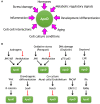The Lipocalin Apolipoprotein D Functional Portrait: A Systematic Review
- PMID: 34690812
- PMCID: PMC8530192
- DOI: 10.3389/fphys.2021.738991
The Lipocalin Apolipoprotein D Functional Portrait: A Systematic Review
Abstract
Apolipoprotein D is a chordate gene early originated in the Lipocalin protein family. Among other features, regulation of its expression in a wide variety of disease conditions in humans, as apparently unrelated as neurodegeneration or breast cancer, have called for attention on this gene. Also, its presence in different tissues, from blood to brain, and different subcellular locations, from HDL lipoparticles to the interior of lysosomes or the surface of extracellular vesicles, poses an interesting challenge in deciphering its physiological function: Is ApoD a moonlighting protein, serving different roles in different cellular compartments, tissues, or organisms? Or does it have a unique biochemical mechanism of action that accounts for such apparently diverse roles in different physiological situations? To answer these questions, we have performed a systematic review of all primary publications where ApoD properties have been investigated in chordates. We conclude that ApoD ligand binding in the Lipocalin pocket, combined with an antioxidant activity performed at the rim of the pocket are properties sufficient to explain ApoD association with different lipid-based structures, where its physiological function is better described as lipid-management than by long-range lipid-transport. Controlling the redox state of these lipid structures in particular subcellular locations or extracellular structures, ApoD is able to modulate an enormous array of apparently diverse processes in the organism, both in health and disease. The new picture emerging from these data should help to put the physiological role of ApoD in new contexts and to inspire well-focused future research.
Keywords: ApoD; extracellular vesicles; lipid peroxidation; lipoprotein particles; lysosome; membrane management; oxidative stress; protein physiology.
Copyright © 2021 Sanchez and Ganfornina.
Conflict of interest statement
The authors declare that the research was conducted in the absence of any commercial or financial relationships that could be construed as a potential conflict of interest.
Figures







References
-
- Akiba S., Arai N., Kusuoku H., Takagi Y., Hagura T., Takeuchi K., et al. . (2011). The N-terminal amino acid of apolipoprotein D is putatively covalently bound to 3-hydroxy-3-methyl hexanoic acid, a key odour compound in axillary sweat. Int. J. Cosmet. Sci. 33, 283–286. 10.1111/j.1468-2494.2010.00636.x - DOI - PubMed
-
- Albers J. J., Taggart H. M., Applebaum-Bowden D., Haffner S., Chesnut C. H., Hazzard W. R. (1984). Reduction of lecithin-cholesterol acyltransferase, apolipoprotein D and the Lp(a) lipoprotein with the anabolic steroid stanozolol. Biochim. Biophys. Acta 795, 293–296. 10.1016/0005-2760(84)90078-X - DOI - PubMed
Publication types
LinkOut - more resources
Full Text Sources
Miscellaneous

